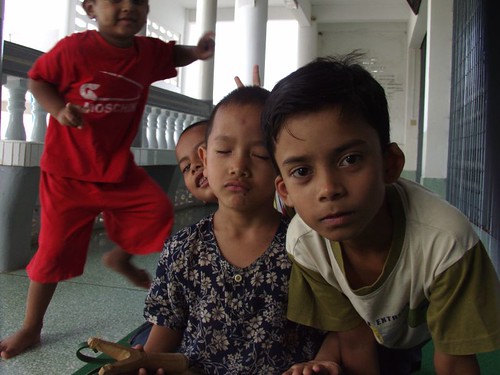These are kids in Myanmar, also known as Burma. They live in a town called Tachilek, on the border of Thailand. I met them in a mosque — a very small mosque on a sidestreet in the town. There is a lot of dispute about the position and treatment of Muslims in Myanmar, a predominantly Buddhist country. I was happy to meet these boys — the one in the middle was particularly funny, meditating like a Buddhist monk but holding a slingshot in his hand. I don’t think they get many visitors.
I had planned to visit Yangon (Rangoon) with my friend Anil Kalhan in the second weekend of May, which was incidentally the weekend of the country’s constitutional referendum. Not surprisingly (though, I have to say, I was still a bit surprised) the Myanmar Embassy in Singapore closed its visa section for a few days about a month before our weekend sojourn. And then for the week after that. And the next week too, which was when Cyclone Nargis hit. When we finally got to the visa counter (on now my fourth visit to the embassy) we were told that a visa could not be ready until Monday, the Monday that we were supposed to return to Singapore.
So, our Yangon trip didn’t work out. Not to be deterred, we decided to take the back door to Burma. We went to Chiang Mai in Northern Thailand. We wandered around the city and met some people there who told us a lot about what was happening across the border in Burma. Then we went by bus to Mae Sai, the border town on the Thai side and our gateway to a country neither of us had ever seen but were very curious about.
Crossing the border by foot was a strange experience. It should have been a bigger deal than it was. You cross through Thai security, walk on a short bridge over the Sai River, are greeted by a large photo of junta leader Than Shwe, pay 500 baht (we tried to pay US$10, but they didn’t like that our bills had doggy ears), and voila! Myanmar. (Myanmar without our passports, that is. They hold on to them until you return.)
Tachilek and Mae Sai sit inside the Golden Triangle, the area where Thailand, Burma and Laos meet. It’s a place notorious for opium production, hilltribes and the spread of HIV. Not too pretty. But it’s also a place glossed over for tourists — these “dangerous” places have capitalized on their reputations in many ways. So too has Tachilek. The three-wheel taxi drivers have a little route they all follow, showing half-day tourists from Thailand Shan temples, Chinese-style temples and the beauty of the valley where Tachilek rests. Indeed, it is a beautiful country, but one that is conspicuously void of newspapers. Many buildings have satellite dishes, but the televisions we saw were tuned to WWF wrestling from across the border. One week after Cycle Nargis hit, our guide still thought only a few thousand had been killed.
So we wandered around, seeing all the things that all the curious onlookers see and trying to ask questions in between, It is certainly a strange place and one where you don’t speak too loudly, or walk past a polling booth twice, or take photos of referendum posters out in the open. Our guide made that abundantly clear to us. He also made it clear that people in Tachilek didn’t feel that their vote in the referendum was secret — so many voted “yes” to satisfy local leaders. So I took what photos I could — I’m afraid I couldn’t properly capture Tachilek, though.
